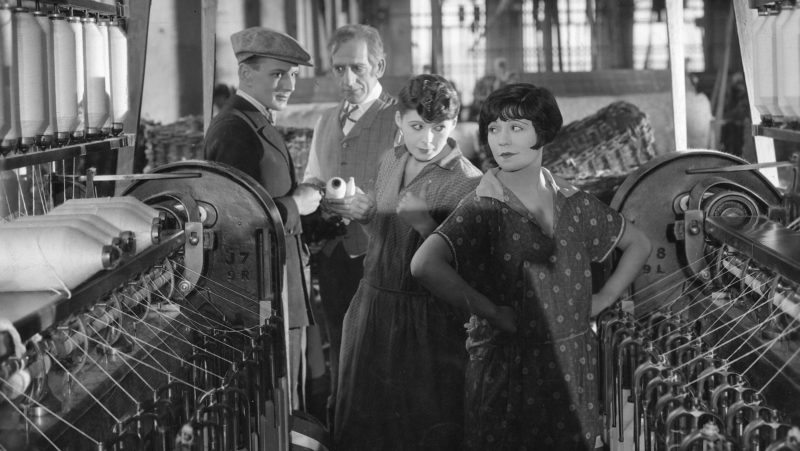THE MID-WEEK EVENT IS HINDLE WAKES, A MASTERPIECE OF ENGLISH SILENT CINEMA WITH A SCORE BY MAUD NELISSEN WHO ALSO DIRECTS A QUINTET OF MUSICIANS
Every screening at the Pordenone Silent Film Festival is unique thanks to live musical accompaniment from morning to night, but when the number of instruments and musicians involved increases, we speak of “special events,” and the special event on Wednesday October 11th is Hindle Wakes (GB 1927). Based on Stanley Houghton’s 1910 play, the film is directed by Maurice Elvey (1887-1967), one of the most prolific directors of British cinema. Elvey was so convinced of the subject matter that he directed two versions, the first in 1918, considered lost, and this one from 1927, which skillfully blends realism and melodrama. Considered a proto-feminist work for the non-conformism of protagonist Fanny Hawthorn, who rejects traditional behavioral models, the film’s plot revolves around an annual holiday, known as “The Wakes,” during which the workers of Lancashire are given a week off from the routine of factory labor. Starring Estelle Brody and set in the fictional northern town of Hindle, the movie is also noted for its innovative camerawork, such as mass shots of a dancing crowd and the breathtaking subjective images of the roller coasters in the seaside town of Blackpool.
A new musical score was commissioned in 2019 by the Kinothek Asta Nielsen with the support of the Bareva Foundation, who tasked Dutch musician Maud Nelissen with composing and conducting a classic “piano trio”: violin, cello and piano, with the addition of soprano/alto saxophone, percussion and accordion. A variety of instruments which, in the musician’s intentions, allow a rapid transition from the more mundane scenes of the first part to the more intimate ones rich in psychological and dramatic depth of the second.
At 11.15 AM we continue the series dedicated to the designer Sonia Delaunay with one of the most significant titles of the French avant-garde of the 1920s, Le vertige (FR 1926) by Marcel L’Herbier. Like Hitchcock’s 1958 film of the same title, Le vertige shares with Vertigo themes such as the disturbing and mysterious return of the dead and the fascination of the double; the plot hinges on the obsession of a woman who, after many years, believes she recognizes her deceased lover in a charming young man on the French Riviera. More than for its story, Le vertige is of extraordinary importance as a true manifesto of modernism, with scenes by Robert Mallet-Stevens, one of the greatest exponents of French Art Deco, and Sonia Delaunay who, in addition to the costumes, designed the fabrics for the furniture, cushions and curtains that appear in the film. In addition, a central element is the 1911 painting depicting the Eiffel Tower by Robert Delaunay, Sonia’s husband. Le Vertige is also a sensational example of overt advertising for the most recent creations in fashion and design from Delaunay’s fashion house.
German cinema is on today’s program with two titles: Der Mann ohne nerven (1924), in the Harry Piel strand, (10 AM) and Die Straße (1923) by Karl Grune (2.30 PM. Der Mann ohne nerven is the first of a series of three films produced by Piel with the French company Gaumont, with the intention of renewing relations between the two countries after the First World War. Filmed mainly in London and Paris, the film was notable for the now lost balloon flight sequences but remains a thrilling example of Piel’s energy and inventiveness. The cast includes the actress Dary Holm (1897-1960) who shortly after became Piel’s wife.
Karl Grune, author of Die straße, is now one of the lesser-known major directors of German cinema but was considered by contemporary critics as one of the most important exponents of European cinema, and his fame was mainly due to this film, defined as “a milestone in the progress of technology and the art of cinema.” Its influence was enormous and launched an entire genre, “the Street film,” which became an important part of later film theorists’ writings when discussing the zeitgeist of the Weimar Republic in the charged years before the Nazi rise to power.
Also Wednesday is the Jonathan Dennis Memorial Lecture in the Teatro Verdi at 5.15 PM, delivered this year by writer, scholar and filmmaker Mindy Johnson, who’ll be talking about Bessie Mae Kelley, “the first woman animator,” and the contribution of other pioneering women in the animation industry.


 Italiano
Italiano
Recent Comments